Tin Tin and
the Mystery of the Golden Fleece (1961) - 7/10
Director: Jean-Jacque Vierne
Year: 1961
Rating: 7.0
Country: France
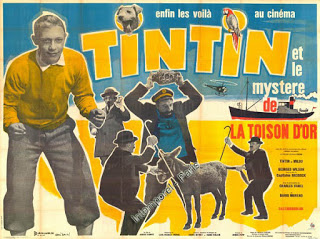
This 1961 Tintin film from France was apparently the first version of Tintin
in the movies. There was another one made in 1964 with the same actor playing
Tintin called "Tintin and the Blue Oranges" that I would love to see as this
one was quite charming and enjoyable. The two films were interestingly original
screenplays and were not based on any of the Tintin books - but after the
films were released they were made into books but not by Herge. In this one
besides Tintin some of his other familiar friends appear - Captain Haddock,
Professor Calculus and Thomson and Thompson. The film is quite well done
with all the actors doing a solid job of imitating the much beloved characters.
It also takes the viewer on some great sightseeing of Istanbul and Greece.
Tintin has long been one of my fonder childhood memories.

Back when I was about 13 years old, Zufir the Pakistani kid who lived behind
us in Ankara, Turkey introduced me into the world of Tintin. He had earlier
tried introducing me into the world of cricket but that didn’t go so well
as I stubbornly insisted on using a baseball bat. American pride I guess.
But I took to Tintin immediately and over the next few months I borrowed
all of his Tintin comic books or comic albums as they are often referred
to and read them all to great delight. Each one is an adventure in which
the intrepid almost boy reporter Tintin gets involved in an exploit in various
parts of the world fighting crime, foul shenanigans or fascists. In these
adventures Tintin is always accompanied by his faithful dog Snowy and usually
his boisterous foul mouthed alcoholic older friend Captain Haddock (beginning
with the ninth book The Crab with the Golden Claws). Along the way, we occasionally
run into some recurring characters such as the bumbling detectives Thomson
and Thompson (based on the author’s father and his twin brother), the absentminded
Professor Calculus, the breaking glass opera singer Bianca Castafiore and
the villain Rastapopoulos. The author of these books was the Belgian Georges
Remi but better known by his pen name Herge.
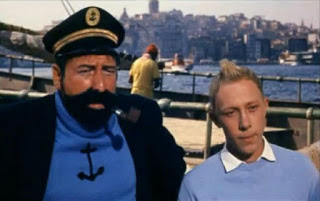
There are 24 Tintin books of which the first was written in the late 1920’s
and the last one in the mid-70’s. The books were a world-wide phenomenon
translated into loads of languages, made into a few films, stamps made of,
serious books written that psychoanalyzed the character of Tintin and his
relationship with Captain Haddock (whether they were gay is often a subject
of study), an animated TV series, dissertations handed in on aspects of Tintin,
fictional novels written in which Tintin loses his seeming virginity and
various comic books created that set Tintin in places that Herge never got
to (and sexual situations as well).

Tintin was never quite as popular in the states as he was in Europe – perhaps
he felt too foreign to parents or we just prefer our comics to be about super
heroes. Of course comparing them to the monthly comic books of our youth
does not feel correct because these are complete adventures (though they
were at times serialized as comic strips in a newspaper) in a book and the
drawing and framing of Herge is truly that of an artist. His boxes are filled
with wonderful detail and color and culture. He was from what I have read
way ahead of his time as an animator with his clean lines and coloring (beginning
with The Shooting Star in 1942). Herge also spent large amounts of time researching
the plots and the cultures that Tintin went to in his adventures.
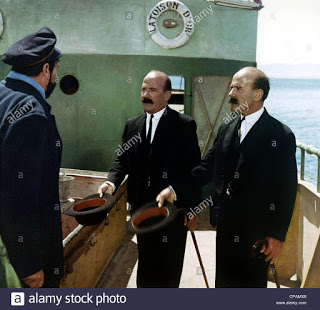
So for a child who loved Superman and Spiderman, these were a step up to
something much more mature and into a real and yet foreign world. I think
many of us hold on to one thing from our childhood and drag it reluctantly
into our adult lives and for me that has been Tintin. I will still pick up
one of the books from time to time to admire the drawing and to meet up again
with what as a child were in some way old friends. But like so many things
that were created long ago there is a dark side to Tintin that has largely
been whitewashed over. In these politically correct times in which we no
longer can admire Woodrow Wilson or Thomas Jefferson and in reality pretty
much anyone who lived pre-1950 or any film made pre-any time, Tintin has
come in for some deserved criticism as well. I suppose it is up to the reader
or film watcher to determine how much to allow political correctness to determine
what you read or watch. But people are products of their environment and
era and Herge was certainly a product of his.
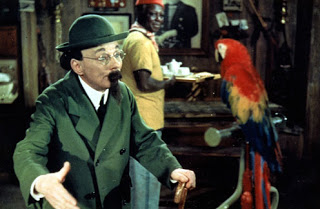
Herge initially wrote his strip for a staunch Catholic right wing newspaper
that verged on fascism and endorsed colonialism and they directed him in
his first two books – Tintin in the Land of the Soviets and Tintin in the
Congo. In the first Herge was told to show the Soviet Union in a very bad
light which he does and in the second Herge paints a patronizing image of
the natives that shows how beneficial colonialism is. Seeing Tintin carried
by a group of locals all looking like Sambo is pretty awful. Later he very
much apologized for this and the book that you would get now has been re-done
to take some of that out. Herge would not allow the Soviet book to be republished
until the 1970’s and it was never colorized or re-done and its lack of artistry
is very evident as Herge grew as an artist constantly. After this Herge took
more control of his material but they are often still filled with stereotypes
of that period. But the main charge against Herge is that when the Nazi’s
occupied Belgium he just went along with it and continued to work on Tintin
at a newspaper that was clearly collaborating with the Nazis (many reporters
left). In two previous books – The Blue Lotus and King Ottokar’s Sceptre
– Herge had very much come out against the Japanese occupation of China and
in Ottokar the fascist like dictator is clearly based on Mussolini and Hitler
- so it was clear where his politics lay. This is all controversial – but
not everyone was a freedom fighter and he still had to eat but it stuck with
him after the war.
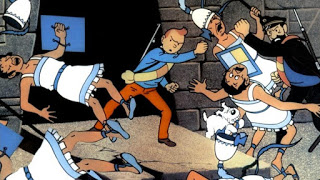
But putting all this aside, the Tintin series are wonderful often amusing
adventures that should be introduced to all children all over the world.
My top three recommendations would be The Blue Lotus, The Shooting Star and
Tintin in Tibet – far flung adventures that are about friendship and loyalty
above all else.
Tin Tin and the Blue Oranges
Director: Philippe Condroyer
Year: 1964
Rating: 5.0
Country: France
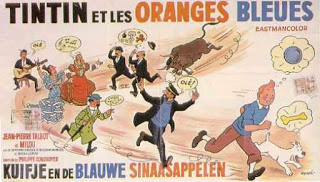
Not as good as the 1961 Tintin and the Golden Fleece but for Tintin fans
still fairly enjoyable. Slower paced, less interesting scenically (most of
it takes place in Spain) and with too much slapstick this film bogs down
and gets too plain goofy at times. But we still have Tintin, Captain Haddock,
Professor Calculus, Thomson and Thompson and in this one the addition of
Senora Castafiore to annoy Haddock. The two actors who play Thomson and Thompson
are in particularly good in their synchronized slapstick. The Belgian actor
who plays Tintin also portrayed him in the first film and shows in both films
some truly gymnastic talent. After this film, he retired and became a teacher.









